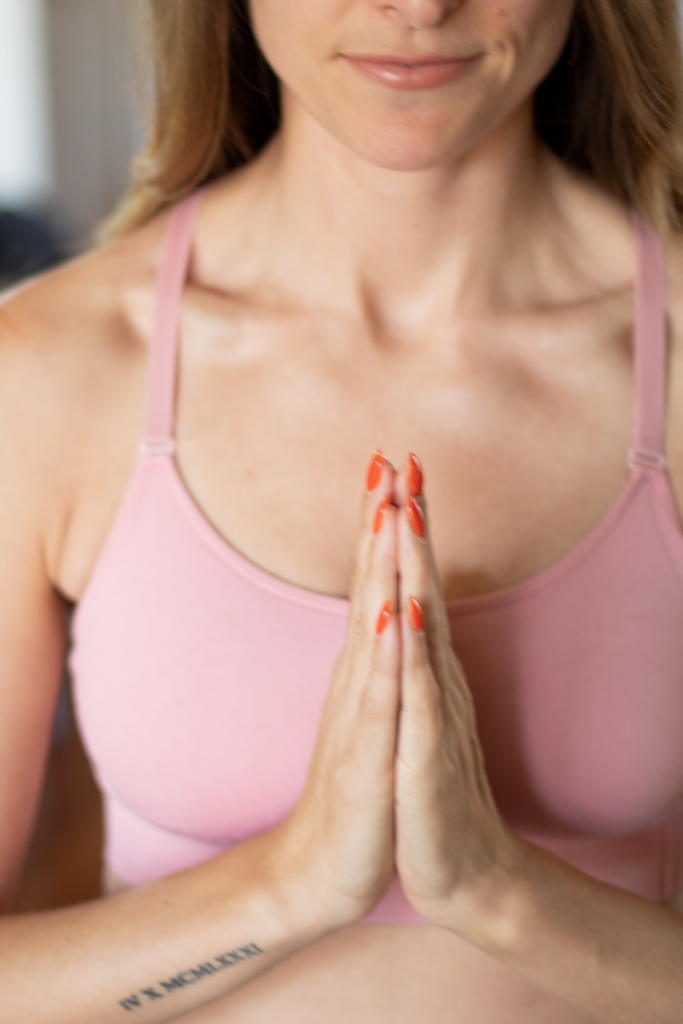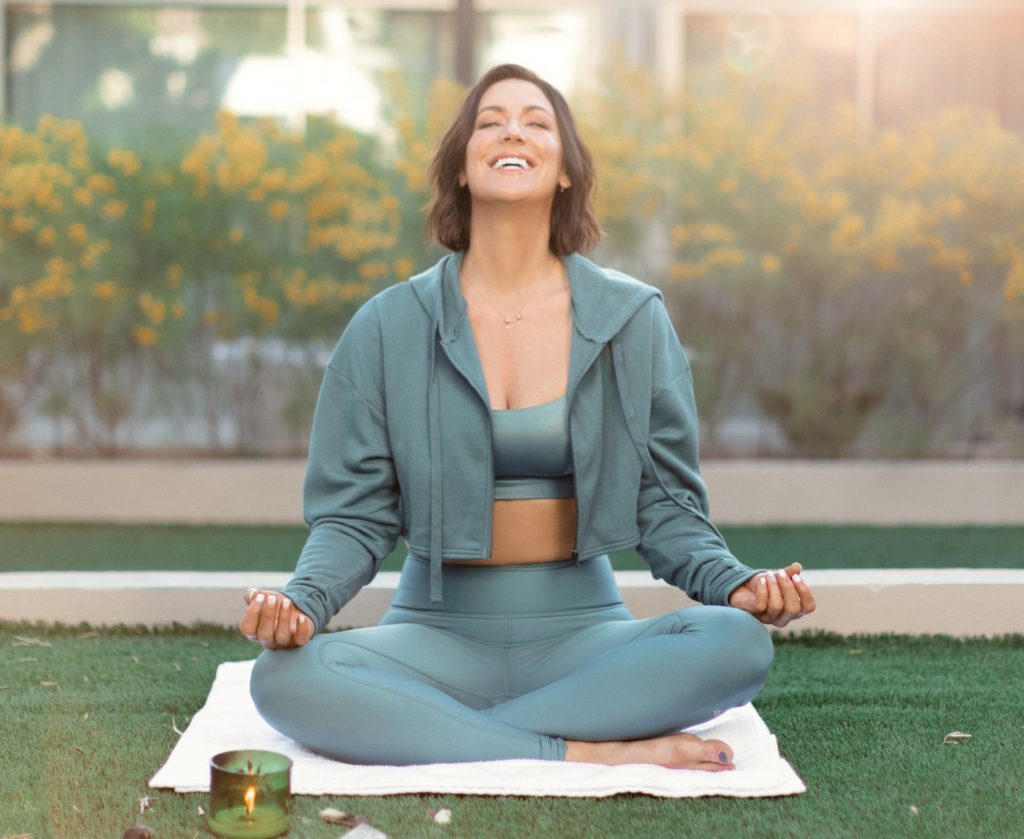Your gain: Understand the benefits of meditation as a technique to decrease your stress, anxiety, improve sleep, and find healing from your loss.
For the longest time, even when my mom was earth side and spoke so highly of meditation, I couldn’t get myself into it. Let’s just get this out there—it can be really hard to sit still and focus your mind. Period. If you struggle with this, too, I hear you. But don’t give up on meditation just yet.
The most important thing to remember about meditation and honing in on that practice is it takes time. Sometimes, a long time. Especially if you’re coping with some demons and have a lot of grief to work through. The number of negative or distracting thoughts that pop in and out of your head throughout the day and night is unyielding at times.
What is Meditation

With meditation, you’re actually training your brain. What exactly does this mean? Well, this article from Forbes quoted Researcher Madhav Goyal who explains, “A lot of people have this idea that meditation means sitting down and doing nothing, but that’s not true. Meditation is an active training of the mind to increase awareness, and different meditation programs approach this in different ways. Meditation isn’t a magic bullet for depression, as no treatment is, but it’s one of the tools that may help manage symptoms.”
Pretty neat, huh?
Moreover, the simple fact is meditation has been practiced for thousands of years. Nowadays, meditation is commonly used for relaxation, stress reduction, and helps engage a deep state of relaxation and a peaceful mind.
The goal is to focus your attention and eliminate the oncoming chaotic thoughts that may be inundating your mind.
The Benefits of Meditation
If you’ve heard anything about meditation, it’s probably the basics. Bottom line, it can help you find a sense of calm and balance that benefits your overall emotional health. The key benefit is using it to relax and cope with stress by refocusing your mind on something calming and within your control. Think: stay centered.
The beauty of it is the following benefits don’t end when your meditation sesh is complete. You’ll feel it throughout the day in the way you carry yourself, your mind, how you react to things, and so on. Here are some other high-level benefits to meditation:
- Gain a new perspective on life or stressful situations
- Gain techniques to manage stress
- Increase your self-awareness
- Focus on the present and gently putting aside past and future thoughts
- Enhance your attention span
- Reduce negative thoughts or emotions
- Increase imagination and creativity
- Reducing negative emotions
- Lower your heart rate and blood pressure
- Improves sleep quality
- Helps fight addiction
- Generates kindness and positivity
- Can be done anywhere!
When I Began Meditating

Meditation didn’t really come into my daily practice until after my dad passed away. Not only had I moved into my parents condo completely surrounded by all of their belongings, but I was barely sleeping. Sure, this was partially because I was horrendously sad and in a very deep hole emotionally. Not to mention everything that came with dealing with their estate, which is another topic entirely. Long story short, it was stressful and I had no idea what I was doing… I still don’t at times. But it was also because there was a lot I wasn’t really dealing with, and I wasn’t giving myself the grace I needed to fix it.
In fact, it was a psychic medium I go to that recommended meditation, and encouraged me to take it seriously. I know, I know… you might not be into psychic mediumship, and that’s absolutely fine. If you are though, or if you’re curious about my journey with one, I plan on doing an entry about that so stay tuned!
Anyway, all I ask as you read is, again, open-minded and give meditation a real shot.
Let’s get into why meditation is so beneficial, what your mindset should be when approaching meditation, and how to practice.
Types of Meditation
There are actually many types of meditation, and this article from Helpline does a great job of listing them and giving a useful explanation of each one.
Instead of listing each one when I’m certainly no meditation expert, I’ll give a quick overview of which kinds worked for me and why. I find these to be some of the most helpful, especially in coping with loss.
Before I do, you may (or may not) be wondering where I find my guided meditations. If not, feel free to skip ahead to the Mindfulness meditation section next.
My Sources for Meditation
When I first started, Youtube was a fairly helpful resource for me. I used this Guided Breathing Meditation with Kim Eng from Eckhard Tolle when I was first getting into it.

Outside of this, I honestly didn’t have a specific one I would use but would continue to explore and find ones that resonated with me.
I’ve also been a long-time Tone It Up! user and fan. I literally can’t put into words how much that community, fitness program, and guidance that Founders Katrina Scott and Karena Dawn (right) have given me. I could go on and on, honestly. One of the features they now offer on their app are yoga flows and meditations. I’ve been using both of those since it launched, and it’s completely changed the way my mind and body operate.
So, without further ado, the types of meditations that have helped me the most:
Mindfulness meditation
In mindfulness meditation, the idea is to pay attention to your thoughts as they pass through your mind. I know, it almost seems a little counterintuitive when trying to remove those thoughts from your mind, right? But here, you don’t judge the thoughts or become entangled with them.
This has been a really beautiful way for me to meditate. Especially in the beginning stages of grief, because I felt like I didn’t need to be ashamed of the thoughts I was having. I didn’t feel further pressure to push them out of my head, then feel guilty and stressed when I couldn’t. It allowed me to embrace my thoughts in a healthy way. Welcome them, say a quick hello but don’t let them linger, then let it go.
Focused meditation
This type of meditation involves concentrating on using your five senses, such as your breath or other external influences to focus your attention. I personally find counting my breaths the most helpful. For example, in for four or five counts through the nose, out for four or five counts through the mouth.
However, this can also be something more tangible to cater to another of the five senses. Perhaps staring at the flame of your favorite smelling candle (I’m the biggest sucker for a great candle, as you’ll learn), counting a rosary or mala beads, listening to a sound like soft music or gong, etc.
Movement meditation
This active form of meditation involves movement, and can help guide you into a deeper level of connection and relaxation with yourself and your surroundings—and be present!
If there’s one thing you should know about me, it’s that I love to walk. I go on at least a 20 minute (usually longer) walk probably five times a week, if not nearly every day. I didn’t realize until later on in my experience with meditation that this was even a form of meditation for me, but it truly is.
Going on walks every day is something my mom always did, so I like to think I got it from her. Finding pleasure out of walking has just always been ingrained in me. But walking also helps me sort through a lot of thoughts and emotions, helps boost my endorphins, and I often get my best ideas on walks.

On the Playlist
Music-wise, when I’m walking, I’m a bit all over the place with my choices. But I have to admit, I love some good pump-up music. Pop-y music is my jam. I also love to listen to inspirational or self-help, badass women-empowering podcasts. For months now I’ve really been enjoying Jenna Kutcher’s “Goal Digger” podcast, Katrina Scott’s (from Tone It Up!) “Live Beautifully” podcast, The Highest Self Podcast by Sahara Rose, and the “Almost 30″ podcast by Krista Williams and Lindsey Simcik.
Get Those Pesky Thoughts Out
I’m not going to lie, there’s a lot of future thinking that occurs on my walks at times which doesn’t really help with the “staying present” idea. However, the beauty about that is I’m getting all of those thoughts out and organized during that time, so it doesn’t end up sneaking its way into my mind when I’m trying to fall asleep. So, I’m not hard on myself about that. This is your friendly reminder not to be hard on yourself about anything during this process!
Keep in mind, movement meditation doesn’t have to be walking. It can be gardening, tai chi, or other low impact forms of movement.
Progressive meditation
This meditation practice involves essentially doing a body scan in an effort to release tension and stress. This is especially useful first thing in the morning (for me), and before bedtime.
Start your focus at your feet and move body part by body part toward your head—calves, thighs, hips, abdomen, chest, shoulders, neck, top of the head and back down. You’ll be amazed at some of the tension we hold in these areas! A big one for me is my shoulders and neck, as it is for many people who hold stress there. If you’re feeling particularly tense one day, give this one a try.
Loving-kindness meditation
I know, this might sound a little cheesy, but hang with me. When you’re feeling especially low and lacking gratitude, this meditation is amazing for strengthening feelings of empathy, kindness, compassion, and acceptance of yourself and others.
This allows you to better open your mind to receive love while also sending well wishes to those around you—friends, family, acquaintances, and all beings around the world. After enough practice, you’d be pleasantly surprised at how light and lifted you feel. Loving-kindness meditation is especially great if you’re holding on to feelings of resentment or anger, and this was definitely me a couple of years ago.
Visualization meditation
Last but absolutely not least because of its incredible power is visualization meditation. This type of meditation focuses on enhancing feelings of relaxation by visualizing positive or happy environments or scenes, images, or figures (such as a lost loved one). The goal is to use your five senses to the best of your ability, in as much detail as you can.
This technique can be really wild, guys. I can’t tell you how many times I’ve used this method and felt like my passed parents or dog were in the room with me, or felt an energy in my left hand. There’s something with the left hand for me, I really can’t put words to it. No joke, I’ve caught myself smiling mid-way through and couldn’t tell you when it appeared on my face.
One of my most beautiful memories were group hugs with my parents when they were here. Just the three of us and sometimes with my dearly departed dog, Princess, in the middle. I swear to you, I can feel them in these moments. I can feel my dad’s bear hug, by mom’s small stature next to me but mighty with grip. It brings me incredible, immense happiness when I’m really missing them. Not one ounce of sadness. A little longing for what I don’t have anymore, yes. But there is no despair to be found.
The Benefits of Visualization
This visualization can also be beyond getting in touch with a loved one, though. Imagining yourself overcoming an obstacle or meeting a specific goal can help increase motivation and focus on the task. This may or may not even have to do with work. Whether you’ve lost your job and are trying to figure out your next step, mourning a friendship or relationship and want to move forward on higher ground. This meditation can be perfect for you.
This practice is beautiful for overcoming grief and visualizing yourself on the other side leading a happier, healthier life. I use this technique to feel closer to places I love, like the East Coast or Italy. Or, envision myself floating in the ocean and feeling complete calm and tranquility. Truly, the options are endless here.
How to Practice Meditation
How you practice could vary depending on the type, but these guidelines below are the most high-level to keep in mind:
Step 1:
Focus your attention. It helps free your mind from distractions that are the core of your stress and concern.
Step 2:
Relax your breathing and focus on it. I have a useful, quick guide to mastering breathing techniques here. The idea is so slow it and control it so you take in more H2O and reduce tension.
Step 3:
Find a quiet setting. Depending where you are or where you live, I recognize this could be difficult. This is a funny analogy, but I think back to an episode of Sex and the City when Charlotte is getting acupuncture. Because of the outside influences of the busy, loud streets of New York, she can’t focus and heads out into the lobby—needles still in and all—complaining to the acupuncturist that she can’t get centered. Dr. Mao brings her back into the treatment room and tells her, “Charlotte, this city will never quiet down. You’re going to have to learn to block out that New York noise and listen only to yourself.”
Thank you, fictional character Dr. Mao… I rest my case.
Step 4:
A comfortable position. I personally find laying down to be the most comfortable way to get the most out of my meditation, but there are many out there that would encourage sitting up straight, head slightly tucked as well. The goal is ultimately good posture.
Step 5:
Have an open mind. Simply put, allow your thoughts to pass through without judgment.
Keep Practicing… You’ve Got This
If your mind wanders throughout your meditation, breathe, come back to the practice, and refocus. Do that as many times as you need to, and understand that meditation takes practice. This can happen whether you’ve been practicing meditation for a matter of weeks, or for years. My best recommendation is to experiment and determine which types work for you. The beautiful thing? There could be more than one! It’s truly one of the favorite parts of my morning, and my reward after a good workout!
Lastly, don’t be afraid to adapt your practice to what you need. For example, some days I love doing guided practice, and some days I just want a little background music and some quiet to still my mind. There’s really no right or wrong way to do it, all that matters is you find some gradual peace and benefit from doing it. doing it.
View comments
+ Leave a comment